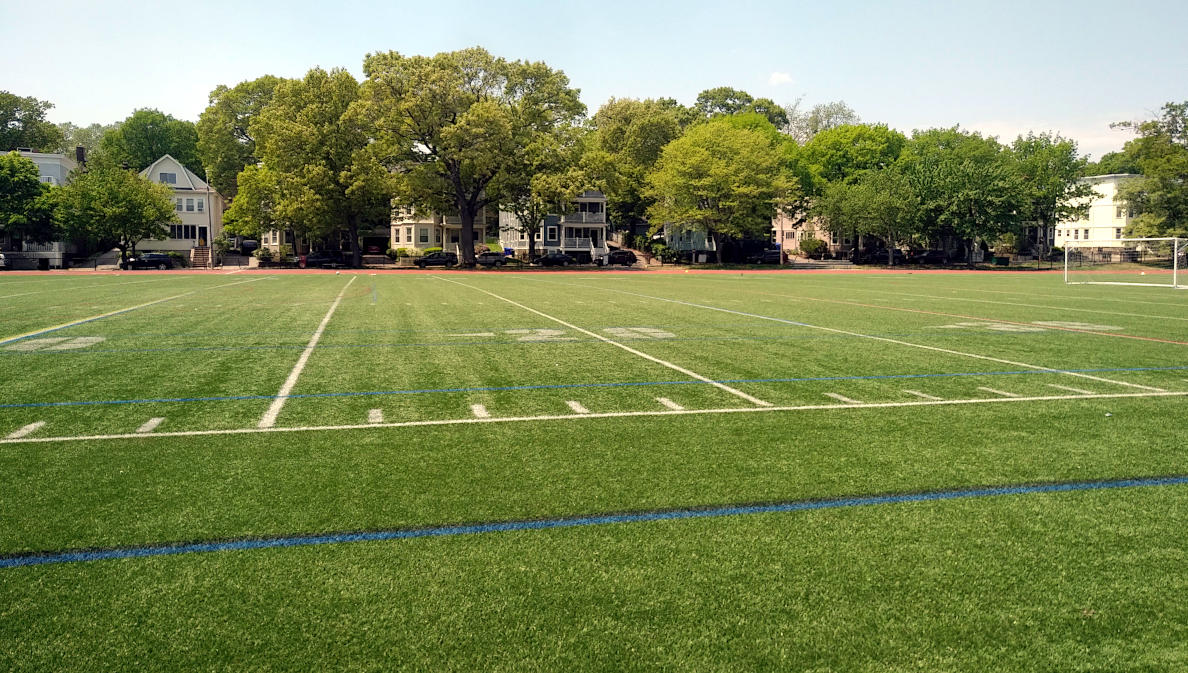Artificial turf fields are being increasingly installed across Massachusetts -- not just at colleges and high schools, but even elementary school playgrounds. The Massachusetts Chapter opposes all plastic turf for the following reasons:

- Each full-size field removes over two acres of ecosystem that sequesters carbon, and covers it with multiple layers of plastic.
- Synthetic plastic fields are much hotter than grass (by up to 55°) regardless of the infill [Penn State], and will create a heat island for the athletes and the neighborhood. (Recorded surface temperatures in the Boston area for artificial turf with organic infill have been as high as 157°F on hot sunny summer days when nearby grass was 102°.) Blistering of athletes' feet, skin burns and heat illness are other concerns with plastic turf. [TURI 2016]
- An artificial turf field consists of a large number of undocumented mixtures of petrochemical plastics and chemicals of varying toxicity. Crumb rubber infill adds significantly to the plastic chemical mix. Underneath the plastic carpet are typically a plastic shock pad, a geotextile and drainage system. Rainwater and any irrigation will wash chemicals and microplastics into the soil, groundwater, and the storm system. But the highest chemical exposure will be the workers and residents in places where plastic and artificial turf is manufactured, which are often environmental justice communities.
- A variety of toxic PFAS chemicals have been discovered in major components of turf fields from many companies. The synthetic plastic grass blades are made in part with fluoropolymers (such as PVDF-HFP) [Gearhart 2021 & Portsmouth Herald 2021], which share the same chemistry as PFAS and are often included in that definition. Surprisingly even some organic infill has been found to contain PFAS. Turf fields release PFAS into local waters [Peaslee 2021], which adds to existing levels of PFAS there and in drinking water across the state.
- Plastic blades and infill generate non-biodegradable microplastics through abrasion and ultraviolet radiation.[Sharma 2016] Athletes, coaches and groundskeepers will be the most heavily exposed. The plastic blades release methane and ethylene, a potent greenhouse gas [Royer 2019].
- A full-size synthetic field will generate over 100 tons of bulky solid waste after about ten years. Plastic recycling is infeasible for artificial turf due to its size, mixtures and toxicity and does not exist in North America [Fair Warning, 2019].
- Artificial turf is unsanitary. The impermeable plastic surface can transmit pathogens (such as MRSA) from human and animal fluids to players and users through dermal contact. Abrasions from turf can increase exposure. Some fields are treated with biocides to reduce infection risk. [TURI 2016]
While there has been no legislation or regulation of plastic turf at the Federal or state level, individual local artificial turf projects have been stopped in communities such as Brookline (2019) and Nantucket (2022). Towns such as Concord (2022), Sharon (2020) and Wayland (2019) have instituted moratoria on new artificial turf fields.
The Chapter supports grass, a safe, cooling, non-toxic, zero-waste, climate-mitigating surface in order to protect children and provide equitable access to nature at our parks and playgrounds.
Resources: Toxics Use Reduction Institute - Athletic Playing Fields Northeastern University: PFAS Project Lab - PFAS in Artificial Turf Fields: Uncertainties and Cause for Concern